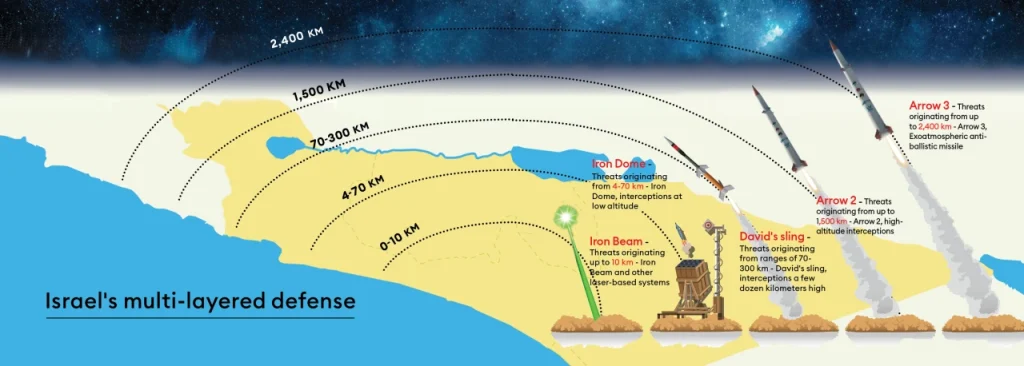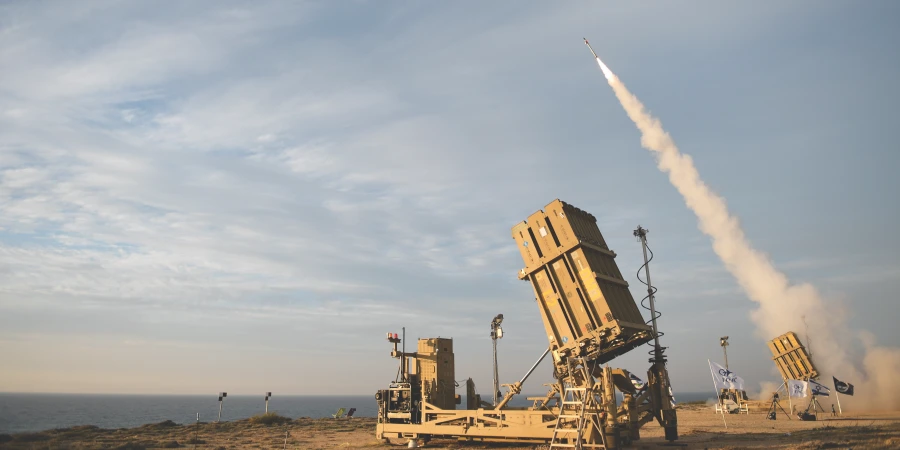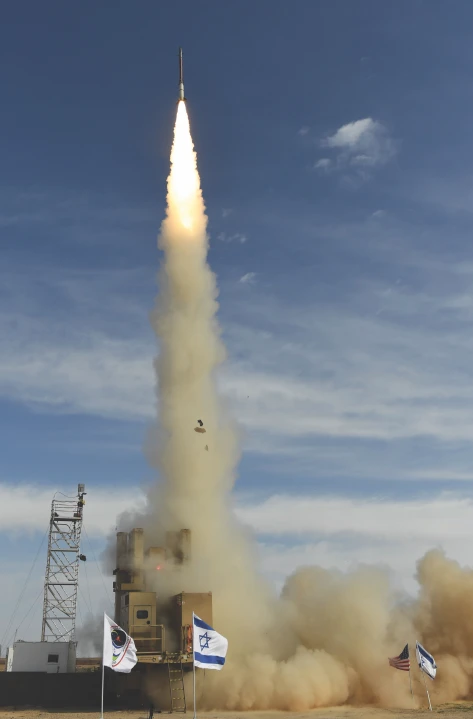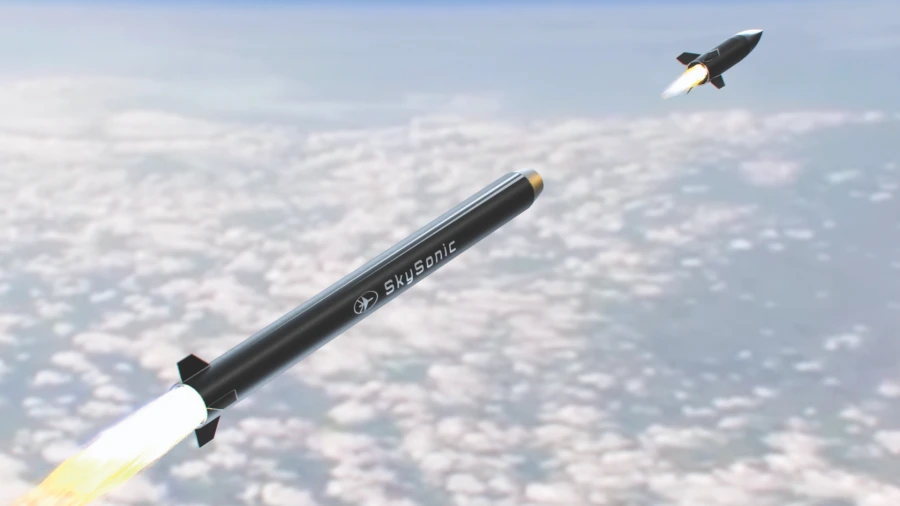On Monday, September 16, 1968, in the evening hours, a precedent-setting event occurred in Israel – Katyusha rockets were fired towards a populated area in Israel. The first-ever barrage was launched from Jordan, toward Beit She’an, and fortunately resulted in only a few injuries, with no loss of life. Three months later, on December 31, Kiryat Shmona suffered its first barrage of Katyusha rockets and the first three fatalities. The northernmost city in Israel became for several decades the primary target for high-trajectory fire from Lebanon. Throughout the 1990s, about 300 Katyusha rockets and mortar bombs were fired at the city, causing the death of 5 civilians and one soldier, and injuring 167 people.
Over the years, the range of threats expanded – Israel’s enemies recognized the difficulty of breaching Israel’s borders on one hand, and on the other hand, they saw the ease and effectiveness of attacking the Israeli home front by using high-trajectory weapons. The small, light, and inexpensive rockets became the weapon of choice for terrorist organizations fighting Israel. They were easy to smuggle, hide, and launch, and were available for purchase in large quantities. Although these rockets were mostly primitive and inaccurate, in large numbers, they became a significant threat. During the Second Lebanon War, still without the Iron Dome, about 4,200 rockets were fired at Israel. Even though nearly 80% did not hit populated areas, the 20% that did hit, killed 56 civilians and soldiers and wounded approximately 2,000. Life in northern Israel practically stopped for over a month.

The first recorded rocket launch from the Gaza Strip occurred on April 16, 2001, towards Sderot. It was a small and primitive rocket with only half a kilogram of explosives. Yehuda Ben Maman, the security officer of Sderot, stated that “it looked primitive and not threatening at all… we were sure it was going to be a one-time event”. Unfortunately, that was not the case and the attacks from Gaza grew exponentially – in 2001, 4 rockets were fired into Israeli territory. Two years later the annual tally was already 155, and by 2006, nearly 2,000 rockets were launched in a single year. For scale, Hamas launched around 3,000 rockets in the opening hours of the Swords of Iron War on October 7th.
The first recorded rocket launch from Gaza occurred on April 16, 2001, towards Sderot. It was a small and primitive rocket with half a kilo of explosives. Yehuda Ben Maman, the security officer of Sderot, stated that “it looked primitive and not threatening. we were sure it was going to be a one-time event”
Over the years, Israel invested enormous efforts in dealing with the high-trajectory threat: to thwart smuggling from the sea, the navy embarked on a series of operations, and at least three ships carrying tons of weapons were captured between 2008 and 2014. To prevent smuggling across the Egypt-Gaza border, the air force, according to foreign media, attacked in Sudan and other places to cripple the production and supply chain of Iranian rockets intended for the Gaza Strip. Finally, when the terrorist organizations turned to self-production or managed to smuggle externally produced rockets into the Strip, the IDF carried out a series of operations in the Gaza Strip.
From targeted operations to large-scale warfare
The Israeli operational record in the Gaza Strip can be divided into four periods: first, in 2004-2008, around the time Israel pulled out of the Gaza Strip and Hamas took over, the IDF conducted several short operations in the Strip that brought only short-lived reliefs but failed to bring any significant change. Second, between December 2008 and August 2014, the IDF carried out three major operations – Operation Cast Lead, Operation Pillar of Defense, and Operation Protective Edge. Each secured periods of calm for anywhere between a few months and up to a couple of years, but did not prevent the terrorist groups in Gaza from rearming. Third, the period between Operation Protective Edge in 2014 and Operation Shield and Arrow in 2023 was characterized by attempts to establish a more stable status quo against the terrorist groups in Gaza with the help of external actors like Egypt and Qatar. It included four major operations of fighting and several limited days of fighting, which gradually increased in intensity. Finally, in October 2023, the war with Hamas broke out, which hopefully will fundamentally change the status quo in Gaza and the region.

Until October 7th, the IDF repeatedly tried to suppress rocket fire and establish deterrence against Hamas and the other terrorist organizations in the Strip. Tried – and failed. Given the reality of limited deterrence options and a lack of political will to reoccupy the Gaza Strip, the best thing Israel could do was “to mow the lawn” – i.e. to occasionally deliver a military blow significant enough to cripple the capabilities of the terror organizations and deter them from trying again for the longest possible time.
The IDF and the Palestinian terror organizations, especially Hamas, found themselves locked in an arms race – Israel improved its intelligence abilities and missile accuracy, and Hamas retreated further into populated areas, and bunkered underneath them. The Gazans improved their rocket capabilities, and Israel continuously improved its defensive capabilities with the Iron Dome. These developments allowed Israel to mow the lawn to the same height each time – that is, to achieve quiet for extended periods despite the growing challenge. In other words, because the terrorist organizations were improving, the IDF needed to constantly improve as well in order to end each combat operation with an outcome similar to the previous one. Without such improvements, even the limited results it managed to secure would not be achieved.
How to stop a missile?
Years of rocket barrages drove Israel to dramatically increase its efforts in the field of missile defense systems. Early efforts were made possible through collaboration in American efforts in the Cold War – In the early 1980s, U.S. President Ronald Reagan announced the “Strategic Defense Initiative”. It was an ambitious program to develop new missile defense systems that would be deployed on the ground and in space. It included radical ideas such as intercepting ballistic missiles using satellites armed with powerful lasers or developing new ground-based defense systems. Its futuristic nature dubbed the program “Star Wars.” In retrospect, the system was not technologically viable, but it brought Soviet leaders to the realization that they could not win the arms race against the U.S. Many believe it was among the precipitating factors of the end of the Cold War.
In 1991, when Israel was attacked by dozens of Iraqi Scuds, the American Patriot system was deployed in Israel. The first generation of this defense system did not impress, to say the least, and recorded only a 40% success rate at best
When the Cold War ended, the Clinton administration shifted to focus on ground-based interceptors. However, work on several developments that started within the original framework continued. Israel took part in the project from an early stage, even though a ballistic missile launching from Moscow was not high on its security threat scenarios. What sparked Israel’s interest was the tightening of relations with the U.S. and the development of critical knowledge for defense against smaller missiles. Both manifested in the Israeli-US joint development of the “Arrow” defense system.
In 1991, when Israel was attacked by dozens of Iraqi Scuds, the American Patriot system was deployed in Israel. The first generation of this defense system did not impress, to say the least, and recorded only a 40% success rate at best. The Patriot’s guidance system, originally developed as an anti-aircraft system, was not adapted to the speed of the Scuds and in most cases failed to hit the missiles. In other cases, where Patriot missiles did hit the Scuds, they failed to destroy them. After the war, the development of the Arrow system was accelerated. The system first successfully intercepted a missile in a test in June 1994 and became operational in 1998.
Not Every Interception is a Blessing
Israel’s interception systems are an unprecedented technological success story in world history. Every rocket that is intercepted saves lives and allows leaders to plan and respond more rationally. However, quite paradoxically, the better the defense systems get and the more secure Israelis feel under the threat of rockets, the greater the challenges and negative consequences that Israel needs to deal with. First, as massive rocket attacks cause only minimal damage in Israel, the legitimacy for Israel to retaliate diminishes accordingly – international legitimacy and questions about the proportionality of the response are impacted by the direct damage that is caused and not by the social and psychological impact of sending hundreds of thousands of Israelis to seek shelter in the middle of their day.
Domestic legitimacy in Israel for a massive retaliation is not always assured as well – especially against the backdrop of Prime Minister Benjamin Netanyahu’s rule, who was always suspected by half of the people of acting out of political motives. All these pressures significantly limited Israel’s offensive retaliation to rocket attacks and compromised its deterrence posture, as it seemed it was possible to attack Israel with rockets and get away with it.
Second, the astonishing success of the system fueled expectations among the public that every rocket would be intercepted, and accordingly created a sense of disappointment and failure with every miss. Celebrating a 95% success rate naturally means that 5% of the rockets are not going to be intercepted. However, that simple math does little to muddle the sense of failure in Israel every time a random rocket hits a house. This is further aggravated by Israel’s enemies who celebrate every rare success.
These challenges cause some to jokingly suggest would have been better for Israel without the Iron Dome, or at least without such a successful Iron Dome – as without an effective countermeasure Israel would need to be far more aggressive and focus on offense. Of course, no one expects Israel to stop intercepting rockets.
Defense has always been and will always be a central component of Israel’s security concept. However, the breach of the barrier around Gaza on October 7, 2023, served as another reminder of two basic truths in the theory of war: every defense line will eventually be breached – and wars are won by offense, not defense.
The multi-layered defense array
Israel is constantly threatened by a variety of high-trajectory threats, from a ballistic missile launched from Iran or Yemen to Israel, a distance of about 1,500 km, to a rocket launched from the Gaza Strip to Sderot, a distance of only 2-3 km. In order to defend against all possible threats, Israel developed an innovative multi-layer approach. The array combines a variety of systems adapted to different threats, differentiated by their flight speed, flight time and pattern, size, and mass.
The uppermost and farthest layer is designed to intercept ballistic missiles outside the atmosphere, at altitudes of tens of kilometers and hundreds of kilometers from Israel. This layer is currently based on the Arrow 3 system, which recorded its first operational interception during the current war, successfully intercepting a missile launched by the Houthis from Yemen, a distance of about 1,600 km from Eilat. Of all the defense systems, Arrow 3 is the only one in which the interceptor missile is supposed to hit the target precisely and not just create an explosion near the missile or rocket to take it down.

In the second layer, we find the Arrow 2 system, which is designed to deal with ballistic threats launched from ranges of hundreds to about 1,500 km. In 2017, this system recorded its first operational success when it intercepted a surface-to-air missile from a Syrian S-200 air defense battery. Arrow 2 also managed to successfully intercept threats from Yemen during the current war. The aerospace industry is already working on Arrow 4, which is supposed to deal with faster and more maneuvering threats and with splitting warheads. It is destined to replace Arrow 2 in the coming years.
In the third layer is the David’s Sling system (formerly “Magic Wand”), designed to deal with heavy and long-range rockets, fired from 150-200 km, such as those held by Hezbollah and Hamas, as well as with cruise missiles and medium-range ballistic missiles. The system recorded its first operational success in May 2023, when it intercepted rockets fired at Tel Aviv during the Shield and Arrow operation. In the first month of the current war, the system recorded roughly 60 interceptions at an amazing 100% success rate.
Below it, in the fourth layer of defense, operates the well-known system – Iron Dome. The system intercepts short and medium-range rockets at low altitudes. Originally, the system was designed to handle threats from ranges of 4 to 70 km, but this range has been significantly expanded since. Since becoming operational, the system has intercepted thousands of rockets, showing steady improvement in recent years and maintaining high interception rates in the 90-95% range. The remarkable success has made Iron Dome a source of national pride and a synonym for how technology can provide a reality-changing solution to what seems to be an intractable problem.
Laser-based interception does’t need to factor in supply or cost, so it will try to intercept any threat as soon as it is identified. Successful interception will ensure that the threat is downed over enemy territory. Theoretically, successful interceptions this way will eliminate the need to trigger an alarm in Israel
Finally, in the fifth and lowest layer, laser-based systems are expected to be used to intercept the smallest threats, from short-range rockets, through mortar shells, to gliders and cruise missiles, along with electronic jamming systems to take control of drones.
The Patriot system is also still in use as well and serves as a backup for some of the mentioned systems, alongside specific capabilities for intercepting aircraft – in July 2018, Patriot downed a Syrian Su-24 that penetrated the Golan Heights.
In Israel’s multi-layered array, the defense systems complement each other to maximize interception chances. Thus, for example, if Arrow 3 misses a ballistic missile outside the atmosphere, there will still be enough time for Arrow 2 to try and intercept it inside the atmosphere.

The Next Generation: Lasers and Hypersonic Missiles
Israel’s defense companies are investing significant efforts in developing additional interception systems – in June, Rafael unveiled Sky Sonic, a system that is supposed to be the first to intercept maneuvering hypersonic missiles. This weapon, which the Russians used for the first time in the war in Ukraine, is based on advanced propulsion systems capable of accelerating the missile to speeds of five times and more than the speed of sound – much faster than the rockets the Iron Dome is tasked with intercepting. Coincidentally or not, Rafael’s unveiling came a week after the Iranians announced they were developing their first hypersonic missile “capable of evading the anti-missile systems of the United States and the Zionist regime.”
But even before we see Sky Sonic intercepting hypersonic threats, we will likely soon see Iron Dome reinforced with revolutionary laser interceptors. Laser-based interception is supposed to be more accurate, faster, and especially much cheaper. An interceptor missile of Iron Dome costs about $50,000. Laser interception is supposed to cost only a few shekels. The laser will also not have a supply problem, unlike the limited supply of missile-based interceptors.
Iron Dome needs to weigh the cost of the interceptor missile and the limited missile supply, and therefore tries to intercept only rockets that pose a threat to populated areas and strategic assets. It quickly identifies every high-trajectory threat and calculates its estimated impact site. To do that, it must wait until the rocket has stabilized in its trajectory. Only then is the decision made to launch an interceptor, and a few more seconds pass before the rocket is actually intercepted. Due to the short ranges, in most cases, the interception is performed over Israeli territory, and alarms are activated both in the area of the estimated impact and under the area of the expected interception.
Laser-based interception, on the other hand, does not need to factor in supply or cost, so it will try to intercept any threat as soon as it is identified. Successful interception will ensure that the threat is downed over enemy territory and not over Israel. Theoretically, successful interceptions this way will eliminate the need to trigger an alarm in Israel.
The first laser system expected to be used is Rafael’s Iron Beam The system’s developers announced a technological breakthrough last year and were supposed to start the first operational trial next year. Due to the war, the schedule has been pushed up. Rafael is keeping the cards close to the chest, but the system will likely be fielded during the current war.

Rafael unveiled Sky Sonic, a system that is supposed to be the first to intercept maneuvering hypersonic missiles. Coincidentally or not, Rafael’s unveiling came a week after the Iranians announced they were developing their first hypersonic missile “capable of evading the anti-missile systems of US and the Zionists”
Alongside the development, the defense establishment has also been working in recent months on lowering expectations from Iron Beam. Accordingly, we heard the system will come in addition to the Iron Dome and will not replace it. It will not work in rainy conditions and will also not be effective against heavy rockets and missiles, which usually include heat protection layers that will likely also protect from a laser beam trying to heat them to the point of explosion. Most importantly – it is still unclear how much time a laser beam that heats a target will require to bring a rocket down. The answer will directly impact the number of targets Iron Beam could deal with simultaneously. A single battery of Iron Dome can deal with dozens of targets simultaneously thanks to the use of multiple launchers. Will a laser-based system also be able to deal with dozens of rockets and still manage to intercept all of them over enemy territory?
Looking further into the future, Israel’s missile defense plans include a variety of laser-based systems that will be deployed not only on the ground in Israel but also on drones that will patrol over enemy territory and intercept any threat the instant it is launched. IDF maneuvering forces are also supposed to get laser-based interception systems at some point. In other words – we are nearing a revolution in Israel’s defense abilities in the coming decades. Alongside the multi-layered defense array that already provides a shield over Israel, more and more systems will appear that will effectively deploy a virtual wall over the skies of enemy territory, preventing most threats from crossing into Israel, where they will face the other defense systems like Iron Dome.
After we covered the unprecedented achievements of the Israeli aerial defense systems, it is worth remembering that Israel also invested billions in an advanced defense barrier, equipped with state-of-the-art electronic detection systems. These were supposed to prevent the infiltration of terrorists from Gaza. On October 7 of this year, a few dozen explosive charges that were followed by several bulldozers were enough to break through the sophisticated fence, opening the way for thousands of terrorists to commit the greatest massacre the Jewish people have known since the Holocaust.
International Interest
As mentioned, the Israeli interception systems are an unprecedented international technological success. Not for nothing is the list of buyers for Iron Dome, David’s Sling, and Arrow constantly keeps growing. The real-world and very public demonstration of Israel’s interception systems, alongside the growing threats from Russia, has made the Israeli systems the hottest commodity on the market.
In August, Germany preferred the Arrow 3 system over the American THAAD, in a deal estimated at 14 billion shekels ($3.75B), the largest defense deal in Israel’s history and the first sale of the system to another country. In November, during the Swords of Iron War, a deal with Finland was closed to sell David’s Sling system for 1.3 billion shekels ($350 million).
Iron Dome, the most active system is also the most popular one, by far – about 100 units of the Iron Dome’s advanced radar and command and control systems have been sold to the likes of Britain, Canada, India, South Korea, the Czech Republic, Hungary, and Slovakia. The number of countries that have purchased interceptors is significantly shorter – The United States was the first to purchase several batteries for its army and Marines – some of those batteries were shipped back to Israel last month as part of the US’ emergency aid.
Israel also agreed to sell the Iron Dome to Azerbaijan, following a state visit by Netanyahu in 2016. Azerbaijan, which borders Iran, is a vital ally of Israel. Ukraine as well has also asked several times to buy the Iron Dome to protect against Russian attacks, but was turned down given Israel’s delicate relationship with Russia who has influence over Syria. However, given Russia’s tightening relations with Iran and growing anti-Israeli sentiment from Moscow during the war, it is not far-fetched to assume we will see Iron Dome batteries protecting Kyiv in the near future.





